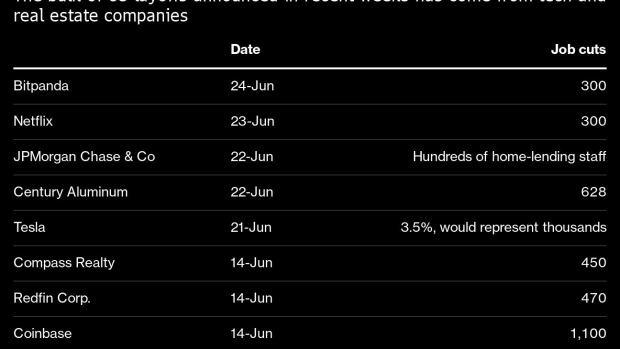Jun 25, 2022
US Layoffs, Hiring Freezes Are Tip of Labor Market Slowdown
, Bloomberg News

(Bloomberg) -- The US labor market is stronger today than many thought possible. But cracks are emerging, signaling that it’s not going to last.
In the past few weeks, companies have announced tens of thousands of job cuts and plans to freeze hiring. The bulk has come from technology, cryptocurrency and real estate firms big and small, which have laid off at least 37,000 workers since May, according to tech job-listings website TrueUp. Brokerages and banks including JPMorgan Chase & Co. are reducing headcount as the housing market cools.
The combination of slowing consumer demand, 40-year high inflation and the Federal Reserve’s interest-rate hikes is seeping into other sectors, too. The country’s second-largest aluminum producer, Century Aluminum Co., said it was laying off about 600 workers.
Economic data suggest more is on the way. Manufacturing overtime hours have declined for three months in a row, the longest downward streak since 2015. The four-week average of jobless claims, which is less volatile than the weekly figures, climbed to the highest level since January as more people filed for benefits. And wage growth across the country is cooling.
“The anecdotal evidence is piling up. Workers are definitely losing some of their bargaining power,” said Bob Schwartz, senior economist at Oxford Economics. “We are at a tipping point and what the Fed is doing is going to accelerate the process.”
The question for economists is not whether the labor market will slow down, but how quickly.
In its bid to tamp down on inflation, the Fed hiked rates by 75 basis points at its June meeting -- the most since 1994 -- and Chairman Jerome Powell is eyeing at least a 50-basis points increase at the next meeting.
That’s prompted growing recession calls from economists as consumer and corporate lending demand weakens. Powell himself acknowledged this week that a recession is possible, though not inevitable.
So far, firings have largely been constrained to interest-rate sensitive industries such as real estate. During the pandemic, low rates and trillions of dollars in fiscal stimulus propelled home sales to the highest in more than a decade. Now, mortgage rates have soared to the highest since 2008, deterring would-be buyers. Lenders and agencies suddenly find they don’t need all those employees.
Tech firms are also contending with higher borrowing costs. Many of the companies that are now cutting jobs said they hired too many workers during the pandemic to meet the sudden influx of demand when the economy began to reopen. And crypto companies like Coinbase Global Inc., which is cutting more than 1,000 staff, have been hit by a severe rout this month following explosive growth last year.
Hiring Freeze
Cost-cutting measures are spreading to other sectors.
One nonfinancial-service firm told the Richmond Fed that its plans for hiring and spending are on hold because clients are capping or cutting budgets. Another services company told the Kansas City Fed it too instituted a hiring freeze after sales dropped, adding it’s looking to cut costs.
The Fed’s interest rate hikes are engineered to slow down demand, and that includes demand for workers: The central bank forecasts an increase in the unemployment rate to 4.1% by 2024. That’s optimistic when compared to recent Wall Street estimates: Nomura Holdings Inc. sees the rate jumping to 5.9% by the end of that year. That would be about the level of June 2021.
For now the labor market remains tight. The jobless rate, at 3.6% in May, is historically low, and payrolls rose by a healthy 390,000 that month. Wage growth is historically high, when excluding inflation. While new job postings declined slightly in recent weeks, they remain 54% higher than before the pandemic, according to data from jobs website Indeed.
But traditional indicators tend to lag. For instance job openings tracked by the government in April fell by the most since the pandemic first hit the US. But May numbers won’t be released until July.
“The labor market is currently strong -- but it’s deteriorating and it’s going to deteriorate pretty quickly,” said Troy Ludtka, senior US economist at Natixis North America LLC. Ludtka forecasts the unemployment rate to hit at least 5% by the start of 2023.
“The tightness that we’re seeing now is in response to the massive burst of growth we saw a year ago,” he said. “Now, the economy is slowing, which means the labor market is going to slow.”
©2022 Bloomberg L.P.





